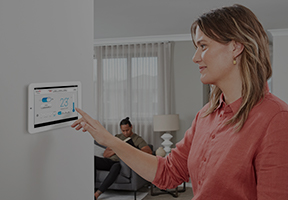What is the Defrost function?
Questions are often asked regarding heat pumps and their requirement to defrost. This FAQ attempts to answer some of the most common questions^.
Defrost function is a feature on every heat pump and is designed to remove the ice build-up on the outdoor unit heat exchanger. Ice build-up on the outdoor coil occurs during the heating process of the heat pump because the temperature of the outdoor coils drops below zero degrees causing the moisture on the coil to freeze.
Why does it need to happen?
If a heat exchanger is covered in ice, the airflow is restricted and therefore the efficiency of the heat exchanger is greatly decreased. Ice on the heat exchanger also acts as a thermal insulation barrier preventing heat absorption which would reduce the unit's capacity to heat and eventually cause it to stop. By defrosting the heat exchanger the efficiency is increased.
How can I tell if my unit is defrosting?
Most units will indicate defrost by flashing LEDs on the front cover. This may be a red or green LED depending on the model. Other units that have a wall controller will display a defrost icon.
How often does it need to happen?
This really depends on the following factors:
* How cold/damp is the air around the outdoor unit
* How much work the unit is required to do, e.g. room insulation, thermostat setting is too high or greater expectation to heat adjacent areas
* Are there any mechanical defects with the unit?
* Is the unit sized correctly?
* Are the filters and condenser clean?
* Is the outside unit recirculating its discharge air?
Assuming for now there are no mechanical defects…how often would my unit be expected to defrost?
Most units will not check for a defrost requirement until at least 45 minutes have elapsed from the initial start-up. This period should have given enough time to bring the room to the desired temperature (assuming you have set a realistic and achievable temperature setting).
After defrost has started, how long should it take to complete?
Defrosting function on most units is ended after a certain time has elapsed OR the outdoor unit heat exchanger temperature has risen sufficiently indicating that defrosting can be completed. Defrost termination can occur within 15 minutes.
If my unit is frequently defrosting... what could be wrong?
Regular and unsuccessful attempts to defrost an outdoor unit can be a sign that the system is undersized for the area to be heated. Or possibly you have set the thermostat to an unrealistically high setting. Another factor may be that the unit could have a mechanical defect or suffer from a lack of maintenance. Refrigerant loss, heat exchangers blocked by dirt, restricted airflow due to obstruction such as foliage, blocked filters, or uncalibrated sensors are all possible problems. First, try cleaning the air intake filters to the indoor unit as this may help to reduce the frequency of defrost and will help improve product performance. Also, check your unit is not set to a fixed low fan speed as this will prevent the unit from delivering full heat capacity while it can. Adjust the fan speed to ‘auto fan’ as this allows the unit to automatically adjust the fan speed so the output capacity will match the requirement. If the unit is the correct size and the thermostat setting is realistic, the fan will slow as the temperature rises. Turn the heating on earlier or leave it on in extremely cold conditions. If none of this helps we advise a visit by a heat pump specialist to help diagnose the problem.
If my unit is undersized, what can I do to remedy the problem?
The selection of any heat pump is the responsibility of the installation contractor. If an error has been made with the selection, your redress lies firmly with the contractor. Equipment is not at fault if it has been incorrectly sized for the application.
Is there anything I can do to decrease defrosting?
Your heat pump will need to defrost if the ambient temperatures are low. Keeping the doors and curtains closed will help; Insulate your floors and ceiling if they aren’t already. Only set your thermostat to a maximum of 21 Degrees Celsius and try and reduce the load by closing off zones that aren't being used. This is usually high enough for comfort levels and most sizing calculations would be based on this. Thermostat settings higher than this will just cause your heat pump to work much harder, defrost more frequently, and ultimately cost more to run.
^Answers are deliberately non-technical and do not cover specifics on any particular model, therefore some small allowances should be made for minor technical differences between units that can affect the way defrost is both initiated and then terminated.








